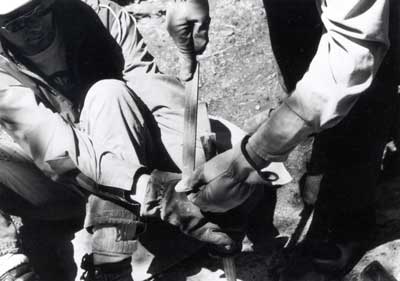Drilling Steel
Sharpening
Make sure that your steel is straight. Bent steel is nearly impossible
to use effectively and a poorly placed blow could glance and cause an
injury. Keep the steel sharp. Sharp steel helps you work safely and
efficiently.
Use a double cut file or grinder to redress steel that is not badly
worn. Maintain existing edge bevels as much as possible. In the field
file the heads smooth and cutting edges sharp. Use a completed hole
as a holder. Insert the steel upside down and brace it with your knee
or foot. Your partner may also hold the steel while you file. Always
wear gloves when sharpening or holding.
When using a grinder, remember to avoid excessive heating of the steel
that could draw temper and soften the bit. Be aware that forged tools
are harder on the outside than they are at their core. Careless or excessive
grinding or filing can expose the core and cause premature dulling.

Using a hole as a holder.

One worker may hold the steel while the other files.
Reconditioning and Tempering
The facilities and expertise of a blacksmith will almost certainly
be required to completely recondition dull drilling steel. Here is an
historical account describing how a blacksmith worked:
"Drills are sharpened, first by forging to the right shape and
to give a sharp edge; this edge, however, by many smiths is not hammered
sufficiently sharp, and they use either a file or a grindstone to
give the required edge. The point is then heated to a glowing red
and dipped in cold water for a few seconds to harden the steel; the
edge is then rubbed on sand to clean it. The smith examines for the
colour, and dips at a pale straw colour to make it hard, or at a dark
blue, which makes it a little tougher. If, after the first cooling,
there is not sufficient heat in the drill for these colours to show
on the edge, it must be reheated in the fire. When the drill is dipped
for tempering, it may remain in the water till cold. The exact colour
at which steel has to be dipped varies with the quality of the steel,
and also, no doubt, with the nature of the work, but a little practice
will soon show." (Lupton, 1906).
Special variations in the temper and length of steel were sometimes
required to drill particularly hard rock.
Modern hand drilling steel has similar forging requirements. In the
reconditioning process it is important for the blacksmith to be able
to control the hardness of steel by tempering. In general, the harder
the steel, that is, the more cohesive the particles of metal, the more
resistant the tool will be to wear. If the steel is made too hard, however,
it may become brittle and break during use.
Standards for the hardness of tempered steel have been established
that guide smiths to the correct hardness for a tool based on its usual
range of applications. Hardness is measured by pressing on tempered
surfaces with specific shapes under a known pressure. The amount of
pressure that the tempered metal is able to withstand before an indentation
is made becomes a measure of its hardness. The best known measures of
hardness of tempered steel for tools are Rockwell and Brinell hardness.
Rockwell hardness tests measure the indentation of a diamond cone (Rc),
or a steel ball of a specified diameter (Rb), on a tempered surface.
Brinell hardness tests measure only with a ball (HB) (see Hardness
Testing Conversion Table).
The steel on the tool's surface is slightly harder than the steel in
the middle. This is because during the quench the particles on the surface
are more radically affected; they are more cohesive than those in the
middle or slightly beneath the surface. The key to tempering is to retain
the desired toughness at the center of the tool. The softer core assures
a strong tool, while the hard exterior provides the cutting edge or
protective shield.
Drilling Steel continued...